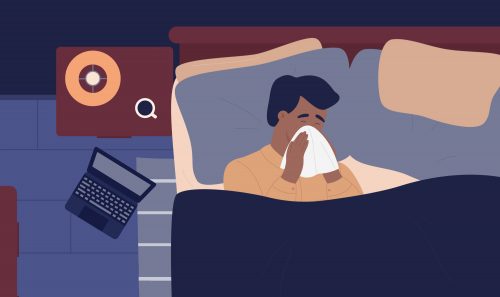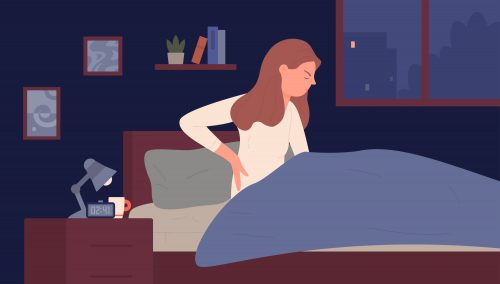While some of us suffer from chronic sleep problems, everyone has had trouble sleeping. Fortunately there are professionals who dedicate careers to helping people learn all the ways they can sleep better and feel better. Experts like Dr. Holliday-Bell, also known as The Sleep M.D., note that the air quality in our bedrooms can affect our sleep quality. According to Dr. Holliday-Bell, “common allergens like pollen, dust mites and pet dander can cause congestion, runny nose and cough that can all impact your sleep quality.”
There are also many ways to improve sleep hygiene by preparing your bedroom. Let’s take a look at different ways the experts suggest you can prepare your air and the rest of your environment for the most hygienic night’s sleep.
The best air for your bedroom
Air is incredibly complex, but there are several ways to prepare the atmosphere in your bedroom for the evening.
Allergens and irritants
There are many different respiratory irritants that can make sleeping more difficult. Allergy triggers in household dust include the obvious mold, pollen, and pet dander. In addition, dust mites live in the vast majority of homes in the world, and they leave behind allergy triggering particles. Even otherwise inert dust particles can harbor toxic household chemicals or pollutants from outdoors.

These particles are very small and can fragment into even smaller bits that cover your bed and are stirred up by motion in sleep which can cause them to float in the air for minutes or hours. To decrease allergens and irritants, try the following:
- Remove outdoor clothing before entering the bedroom to minimize pollen and other outdoor irritants
- Sniff and inspect your bedroom and home to be sure there is a minimal amount of mold
-
Wash your sheets and pillow cases frequently
- Bonus tip: If you know you are allergic to dust mites, consider dust mite covers for your bed
- Vacuum and deep-clean your bedroom weekly
- Consider an air purifier to reduce dust or other particles that may be floating in the air
Molekule air purifiers like Air Pro and Air Mini+ have special filters that capture and destroy small particulate matter, providing you with cleaner air day and night. Dr. Holliday-Bell recommends Molekule because “its PECO technology destroys allergens, pet dander, dust mites and even bacteria and viruses, leaving your air crisper and cleaner. And I love turning it on high so that it doubles as a white noise machine for me.” Watch the video below to see the Sleep M.D. explain why improving the quality of you air can help improve the quality of your sleep.
Temperature
Getting just the right sleep temperature is something that we are all likely familiar with, but different people prefer different sleep temperatures. Comfortable levels can vary from 17°C or 63°F to 28°C or 82°F. However, sleep experts say the sweet spot is narrower– 20°C or 68°F to 22°C or 72°F, with warmer temps causing more disruption possibly because cold, unlike heat, can be solved with more coverings on the bed or a heating pad in extreme circumstances. If you do have trouble sleeping due to heat, you can use cool water to help lower your temperature:
- Keep cold water by your bed to cool your insides
- Consider a cool bath or shower to cool your body
- Place a wet cloth on your forehead as a lot of heat can leave through the head if there is moisture to evaporate

Humidity
The amount of water vapor in the air is directly related to the temperature because hotter air can hold more moisture than cooler air. This is important because it means that cold weather has the potential to dry out our noses and throats, which could cause dry itchy tissue irritation that disrupts sleep. Conversely, too much humidity can foster mold and dust mite growth, and is linked with bronchitis and asthma. Interestingly, both too much humidity and not enough can cause infections.
Relative humidity monitors are cheap and will report if the level in your home is in the ideal range of 40% to 60%. If it’s too high, you may need a dehumidifier, or a humidifier if it’s too low.
Ventilation
This is an often overlooked aspect of bedroom air quality because most of us want to close doors and windows to keep sound out. Without sufficient ventilation, carbon dioxide can build up throughout the night and both make it harder to get to sleep and decrease sleep quality. Even worse, lack of sleep may make you more susceptible to high carbon dioxide levels while awake the following day.
As you exhale overnight, carbon dioxide levels can rise to four or five times their usual level to around 2,000 ppm. Opening doors and windows, even if they don’t open to outside, is the best way to get more ventilation for your space and improve sleep. If you still find the bedroom to be stuffy or stale at any time of the day, putting a fan near a door or installing one in a vent can help to refresh the air.
Simple carbon dioxide monitors are cheap, but models that will track the levels overnight might cost a few hundred dollars. If you are having trouble sleeping or concerned your bedroom air is too stagnant then the investment might be worth it.
The best bedroom environment for sleep
Now that the air has been handled, there are other parts of the environment we want to be sure to address to improve sleep quality.
The best bedding
Having the right mattress and pillow is vital for good sleep quality. In the most general terms, studies have shown that medium-firm mattresses can both help and prevent low back pain. It has also been found that in addition to firmness, the material the mattress is made of affects sleeping temperature and is also something to consider.

Your pillow should not be neglected, either, particularly if you have neck pain. Rubbery or springy pillows have been shown to be better than soft feather pillows for neck pain. Other studies have found that contoured latex pillows are most effective. Regardless, if you have neck pain consider ditching your feather pillow for a springier pillow that fits between your head and shoulder well.
Then, do your own research to find the best mattress and pillow for you. Companies that have mattress technology and research as part of their brand, like our partner Purple Mattress, usually maintain blogs (a lot like this one) to spread the science of sleep. Regardless of what you choose, reading up on how to make that choice always helps.
“Decongest for Better Rest”
First make sure that any allergic reactions from outside your bedroom don’t affect your sleep. Our favorite WedMD sleep expert Dr. Breus likes to say “decongest for better rest” because not only does congestion cause sleep problems, but it gets worse after you lie down. Gravity causes mucus to shift and forces us to breathe through our mouths, which can lead to a dry irritated throat and more coughing. In addition, when your immune system is active due to infection or allergies it can release chemicals that disrupt sleep.
If you are congested before bed, most sleep experts do not recommend using over the counter liquid cold medicines marketed as sedatives because they often contain alcohol that can disrupt sleep and dehydrate the body when it needs fluids most. Acetaminophen, most often sold as Tylenol, is recommended for body aches, fever, or chills instead. Keep in mind that acetaminophen is the only recommended pain killer, nonsteroidal anti-inflammatory drugs (NSAIDs) like aspirin and ibuprofen (often sold as Advil or Motrin) are known to disrupt sleep patterns.
Get the right color noise
The color of a steady noise is often used to describe its particular combination of high and low frequencies. It is common knowledge that white noise can help some of us sleep, but it’s been found out recently that pink noise is even better. White noise is technically defined as noise across the entire sound spectrum, like static from a television. A graph of its frequencies looks like this:

Pink noise has less high-pitched frequencies and is more like leaves rustling, the woosh of a fan, a waterfall, or other more natural steady noise. A graph of pink noise frequencies looks more like this:

Though we haven’t asked anyone if it helps their sleep, the Molekule Air Pro’s fan produces pink noise, as we would expect:

Sleeping with pink noise has been linked with improved memory, possibly as a result of its effect on memory-enhancing sleep. To be sure you are getting the full benefits of pink noise, it’s best to get a dedicated pink noise machine.
We hope our tips for good sleep hygiene help you prepare your home for the best possible night’s sleep. Remember that Air Pro not only removes dust, allergens, VOCs and more from the air, it also tracks other parts of your air not affected by an air purifier, namely carbon dioxide and humidity, to give you one more perspective on what’s in the air.
Keep an eye on our Facebook, Instagram, and Twitter accounts for more healthy science and action on air quality.













